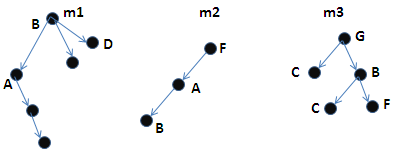Difference between revisions of "Object nets and object trees"
Rene spronk (talk | contribs) |
Rene spronk (talk | contribs) |
||
| Line 19: | Line 19: | ||
[[Image:Object_net.PNG]] | [[Image:Object_net.PNG]] | ||
| − | Note that the resulting object net is a directed graph, where links may be bidirectional in nature. Given the directed graphs (the object trees: M1, M2, M3) the object net, G links to B, and | + | Note that the resulting object net is a directed graph, where links may be bidirectional in nature. Given the directed graphs (the object trees: M1, M2, M3) the object net, G links to B, and B links to F, but F doesn't link to B. |
==Discussion== | ==Discussion== | ||
Revision as of 18:49, 5 March 2010
Contents
Summary
- v3 artefacts, when used in a messaging context, are object trees. When one persists these in a RIMBAA application all objects that share one and the same id are 'merged' into one single object. A stack of trees where objects interconnect based on their shared identity is an object net. Object nets have different characteristics than object trees, e.g. in areas such as context conduction, querying of object net subsets, and object versioning.
Related: Context Conduction in cyclic RIM graphs
Analysis
- Ewout has taken the action item to write an analysis.
- In a real-world scenario one might assign more 'weight' to certain information from certain senders. Or to ignore 'demographics' sent by a Laboratory application. But then again: if the lab sends me stuff about a new patient (i.e. one unknown to me) it may be a best practice to import whatever demographics the lab is sending me. Or the receiver could decide to query the MPI for full details. But all of the above requires contextual knowledge (which senders are masters for what category of information) on the part of the object store.
example
Below an example of three different object trees. The rectangles represent object instances, the labels (A, B, etc.) the business identifiers of the objects. Some objects don't have an identifier. M1 is a directed graph, serialized using starting point B. M2 is serialized using F as its starting point, M3 using G.

Upon receipt of these three structures the receiver will 'merge' the information about one and the same object. Objects A, B and F appear in multiple object trees.

Note that the resulting object net is a directed graph, where links may be bidirectional in nature. Given the directed graphs (the object trees: M1, M2, M3) the object net, G links to B, and B links to F, but F doesn't link to B.
Discussion
- Rene: this is again related to the issue of identity of objects. The business identity of a RIM class is contained in its Id attribute (for Acts, Entities and -managed- Participations).
- For Roles the situation is a bit of a muddle, because one doesn't know if the Role.id is a unique identifier of this single role instance, or whether it is an identifier used for a set of role instances. An example of the latter is a national identifier (e.g. SSN in the USA) to identify multiple roles. In those cases the identity of the role is based on the tuple (Role.id, 'Scoper') where 'Scoper' could be the Entity.id or the Entity.name of the scoping entity.
- This is especially relevant in the process of deciding when to 'merge' objects into an object net.
- Example #1: Dr. Smith is a part-time employee of two different hospitals, A and B. Within each organization he performs a different role (different role.code values). Each role has different contact details, address etc. However: both hospitals (the scopers of the respective roles) both know Dr. Smith using one and the same ID: his 'national healthcare provide identity', 607802. Given that the roles are different, but the Role.id values are the same (607802), one has to use the scoper.Id (A or B) in combination with the Role.id to uniquely identify a role instance.
- Example #2: a RIMBAA application persists an Observation with subject Patient 123 with scoping entity 'hospital A'.
- If it subsequently receives an object tree with Demographics update for Patient 123 with scoping entity 'hospital A' - in that case the patient objects are one and the same.
- If it subsequently receives an object tree with Procedure with subject Patient 123 with scoping entity 'hospital B' - the objects won't be merged - they're not the same.
- If it subsequently receives an object tree with Demographics update for Patient 123 without a scoping entity being present' - the objects won't be merged, the scoper of the new object is unknown and therefore can't be merged automatically with any other Role object.
- As a consequence of the role identity issue described above (this is an open methodology issue), all RIMBAA applications, in order to decide if two roles are the same (one and the same object, just different versions of it) will have to build some kind of "role identity management component". Roles may or may not have an id, scopers may or may not be present, scopers may not have an id, the id may be specified via an IDENT role, the ID of the entity may have to be gleaned of another role played by the entity.. identity crisis, indeed.